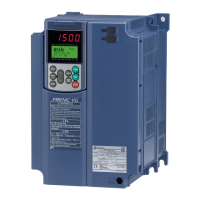5-35
Specifying a too low carrier frequency will cause the output current waveform to have a
large amount of ripples. As a result, the motor loss increases, causing the moto
temperature to rise. Furthermore, the large amount of ripples tends to cause a current
limiting alarm. When the carrier frequency is set to 1 kHz or below, therefore, reduce the
load so that the inverter output current comes to be 80% or less of the rated current.
When a high carrier frequency is specified, the temperature of the inverter may rise due to
an ambient temperature rise or an increase of the load. If it happens, the inverte
automatically decreases the carrier frequency to prevent the inverter overload alarm
NW
. With consideration for motor noise, the automatic reduction of carrier frequency can
be disabled. Refer to the description of H98.
Motor sound (Tone) (F27)
F27 changes the motor running sound tone. This setting is effective when the carrier
frequency set to function code F26 is 7 kHz or lower. Changing the tone level may reduce the
high and harsh running noise from the motor.
If the sound level is set too high, the output current may become unstable, o
mechanical vibration and noise may increase. Also, these function codes may not be
very effective for certain types of motor.
F29 to F31
F33
Analog Output [FM] (Mode selection, Voltage adjustment, Function)
Analog Output [FM] (Pulse rate)
These function codes allow terminal [FM] to output monitored data such as the output
frequency and the output current in an analog DC voltage or pulse (pulse duty: approximately
50%). The magnitude of such analog voltage or pulse rate is adjustable.
Mode selection (F29)
F29 specifies the property of the output to terminal [FM]. You need to set switch SW6 on the
interface printed circuit board (PCB). Refer to Chapter 2 "Mounting and Wiring of the Inverter."
Data for F29 Output form
Position of slide switch SW6
mounted on the interface PCB
0 Voltage (0 to +10 VDC) (FMA function) FMA
2 Pulse (0 to 6000 p/s) (FMP function) FMP
Voltage adjustment (F30) dedicated to FMA
F30 allows you to adjust the output voltage or current representing the monitored data
selected by F31 within the range of 0 to 300%.

